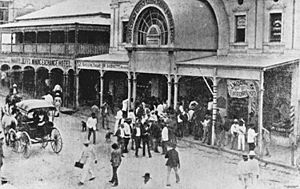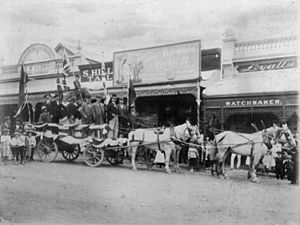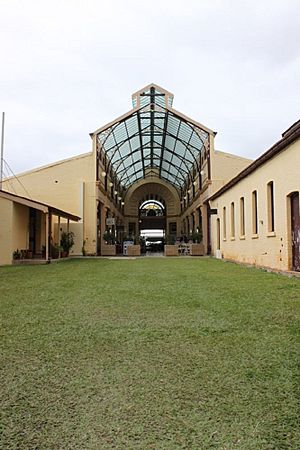Charters Towers Stock Exchange Arcade facts for kids
Quick facts for kids Charters Towers Stock Exchange Arcade |
|
|---|---|

Stock Exchange Arcade
|
|
| Location | 76 Mosman Street, Charters Towers, Charters Towers Region, Queensland, Australia |
| Design period | 1870s - 1890s (late 19th century) |
| Built | 1888 - 1888 |
| Built for | Malcolm Alexander |
| Architect | Mark Cooper Day |
| Official name: Stock Exchange Arcade, Royal Arcade | |
| Type | state heritage (built) |
| Designated | 21 October 1992 |
| Reference no. | 600406 |
| Significant period | 1880s (fabric) 1888-ongoing, 1890-c. 1916 (historical uses) |
| Significant components | assay office, shop/s, gate - entrance, office/s, fence/wall - perimeter |
| Builders | Sandbrook Brothers |
| Lua error in Module:Location_map at line 420: attempt to index field 'wikibase' (a nil value). | |
The Charters Towers Stock Exchange Arcade is a historic shopping arcade located at 76 Mosman Street in Charters Towers, Queensland, Australia. It was designed by Sydney architect Mark Cooper Day and built in 1888 by Sandbrook Brothers. This building was first called the Royal Arcade. It is now listed on the Queensland Heritage Register because of its important history.
The arcade was originally built for a local leader named Alexander Malcolm. It was connected to the rest of the world using telegraph messages. The arcade was used until 1916. It closed because the gold mines were producing less gold, and fewer people lived in the town.
Contents
A Golden History
The Stock Exchange Arcade was built in 1888. It was designed by Mark Cooper Day for Alexander Malcolm. It was a place with shops and offices, and it was first known as the Royal Arcade. In 1890, the Stock Exchange moved its offices here. This made the arcade a very important place for investing in gold mines. This was during the busiest time of Queensland's most important goldfield.
Gold Discovery in Charters Towers
Gold was found in Charters Towers in late 1871. A group of prospectors, including Hugh Mosman, George Clark, James Fraser, and an Aboriginal boy named Jupiter, made the discovery. By early 1872, many people rushed to the area. About 4,500 people were there by the end of that year. In 1874, a business area was set up. This area became the main business and social hub of the town.
How Gold Mining Worked
The way gold was found in Charters Towers was special. It wasn't alluvial gold, which is found in riverbeds. Instead, it was in reefs, which are veins of gold-bearing rock deep underground. This meant that special equipment was needed to dig shafts and get the gold out. At first, small groups of miners and local business people paid for the mines. But as the gold veins went deeper, more money was needed.
The Stock Exchange and Gold Boom
In 1885, some mining agents created a Mining Exchange. This allowed people to buy and sell shares in the mines. This made it possible to invest and make money from the gold. In 1886, samples of gold ore from Charters Towers were shown in London. Some mines were producing huge amounts of gold. This made British investors very excited, leading to a big investment boom.
The boom ended in 1888, but then the famous Brilliant Reef was discovered. This brought new life to the goldfield. Many local business owners replaced their wooden buildings with stronger brick ones. Alexander Malcolm was one of them. He replaced his old buildings with the elegant Royal Arcade.
In 1890, the Stock Exchange became better organized. They chose the Royal Arcade as their new home. It was in a great spot, close to other businesses and banks. The Exchange rented an office and the courtyard for their evening meetings. These meetings were open to the public, and many people came to watch.
In 1892, a new method called the McArthur-Forrest cyanide process helped get more gold. Gold production reached its highest point in 1899. The town's population also reached its peak that year, with about 26,500 people. Charters Towers became the second most important city in Queensland. It was a famous goldfield around the world.
Decline and Restoration
After 1899, the amount of gold from the mines slowly decreased. It also became more expensive to dig deeper for gold. By 1912, it was no longer profitable to mine gold. The population of Charters Towers dropped quickly as people moved to towns closer to the coast. In 1916, the stock exchange closed because there was little interest in new mining projects.
Many buildings from the gold rush era survived because there wasn't much new development. However, the arcade was very large for the smaller population. It became too expensive to maintain.
In 1971, the Charters Towers City Council took over the building. They worked with the National Trust of Queensland to restore it. The first part of the restoration, fixing the front of the building, finished in 1972. The rest of the building was restored in 1975.
Today, the building has offices and shops. An art gallery on the top floor is named after architect Don Roderick. He helped save the building by working with the builder, Bob Aitken, to make it usable again.
What the Arcade Looks Like
The Stock Exchange Arcade is a building made of stone. It has small offices on both sides of a central open area. This central area is covered by a glass vaulted roof. The roof is held up by strong steel trusses. The floor of the arcade is made of tessellated tiles, which are small tiles arranged in patterns.
You enter the arcade through a two-story structure. This part has offices upstairs and shops at street level. The main entrance has a rounded, barrel-vaulted portico that sticks out over the sidewalk. This portico is supported by wooden posts.
The roof of the portico is covered with galvanised iron. The front of the building has colored glass and cast iron panels. On the upper floor, there are pairs of windows. On the lower floor, there's a metal awning supported by posts. The front of the building, called the facade, has a stepped, balustraded parapet at the very top.
The shop fronts, both facing the street and inside the arcade, have large wooden-framed windows. They have colored glass above and cast iron vents. Most of the wooden parts of the shop fronts have been rebuilt. Original wooden stairs lead up to the rooms on the first floor. These rooms are connected by a bridge with a cast iron balustrade. A wrought iron fence, which was likely at the back of the arcade originally, is now at the front.
At the back of the building, there's a large, single-story brick assay house with a galvanised iron roof. An assay house is where they test ore samples to see how much gold they contain. This building now holds a small collection of mining tools. There's also a modern toilet block next to it. The very back of the property is a grassy area with a chain wire fence.
Why It's a Heritage Site
The Stock Exchange Arcade was added to the Queensland Heritage Register on 21 October 1992. This means it's a very important historical building.
- Shows Queensland's History: The arcade shows how important gold discovery was for the growth of north Queensland. It was one of only two stock exchanges outside the capital city. This shows how rich and confident Charters Towers was in the 1800s. The way the arcade looks, almost unfinished at the back, reminds us of how quickly fortunes could rise and fall in gold towns.
- A Rare and Beautiful Building: It's a rare and early example of an arcade in Queensland. People in the community really like its size, its unique barrel vault entrance, its traditional shop fronts, and its detailed design.
- Shows How Buildings Were Made: Its design shows how buildings of that time were adapted for the hot north Queensland climate. It has features that help with ventilation.
- Aesthetic Importance: It is considered beautiful and well-designed. Its scale, the landmark barrel vault entrance, and the traditional shop fronts make it very appealing.
- Community Connection: The arcade has a strong connection with the community. It is also linked to the start of the National Trust of Queensland's branch in Charters Towers.




